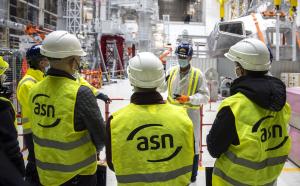The next step in ITER licensing
In January 2022, the French nuclear safety regulator ASN (Autorité de sûreté nucléaire) issued a letter in which it stated that it could not release the ITER Tokamak assembly "hold point" as was foreseen to happen on 1 February 2022, and requested some further clarifications. These "hold points" are a customary part of ensuring the "as-built" safety of any nuclear facility, after ASN provided the decree authorizing the creation of the ITER facility based on a design review in 2012. In this article, Newsline explains the hold point process.
In 2012, ASN validated the proposed ITER design and signed the Décret d'autorisation de création of ITER as a nuclear installation. This step authorized the ITER Organization and its Domestic Agencies to proceed with construction, manufacturing, and installation of the ITER facility. However, as with any nuclear installation, ITER is required at each stage to demonstrate that its safety-relevant buildings, civil structures, systems and components conform to the approved design and meet the safety case in the "as-built" or "as-installed" condition.
To oversee these aspects of safety, ASN has put certain "hold points" in place as part of the normal regulatory process. For each such hold point to be lifted, ITER must first demonstrate the associated safety elements and receive ASN's approval.
The specific hold point now under review was established by ASN in November 2013. Under this hold point ITER cannot begin to weld the first two sections of the vacuum vessel together in the Tokamak pit—an assembly step considered irreversible—until certain safety aspects related to the B2 slab (a 120-metre long, 80-metre wide, and more than 1.5-metre-thick mass of reinforced concrete supporting the Tokamak Complex Building) have been validated. First, ITER must demonstrate the as-built safety performance of this B2 slab. Second, ITER's radiological maps, which calculate the shielding effects of concrete and steel barriers that contain the radiation from the machine, must demonstrate that radiation levels will be safe wherever humans are present without requiring extra shielding material.
Technical discussions and requests for information are a normal part of the process, especially in a "First-of-a-Kind" machine such as ITER, which is also of course a "First-of-a-Kind" facility for ASN. In its January letter, ASN outlined a number of issues that must be further addressed for this hold point to be lifted. Additional modelling of the B2 slab is needed to confirm that the "as-built" masses supported by the slab will be safe under extreme conditions. Second, complementary explanation is needed on ITER's radiological maps to demonstrate that radiation protection requirements will be met. And ASN has asked for more analysis to validate the vacuum vessel welding process, to account for some limited dimensional nonconformities the ITER Organization has identified at the interface between the two vacuum vessel sectors now on the ITER site, which require adjustments to the robotic welding procedure.
This ASN action has not impacted the ITER assembly schedule to date. As Newsline readers well know, the first full sector subassembly—consisting of the double-walled vacuum vessel sector, a tightly fitted thermal shield, and two toroidal field coils—has been completed and will be transferred into the Tokamak pit in the coming weeks. The fabrication of the second subassembly has begun, but it will take several months to complete, and still more time before it is inserted into the Tokamak pit and preparations can be made for welding.
However, as with any such regulatory action, ITER takes these ASN concerns very seriously. Experts are vigorously preparing the additional information and analysis required, with the goal of providing key answers to the ASN during the second quarter of 2022. As Director-General Bigot has stated recently, he is hopeful that this will allow ASN sufficient time to consider the additional information and release the hold point without impacting the ITER assembly schedule.


